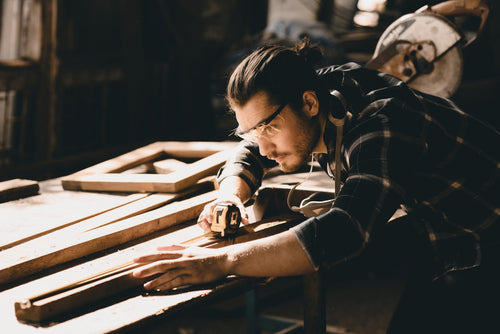In today’s world of two-day shipping and decreasing home ownership, most have not learned the satisfaction of building something from nothing with our hands. Why should we? The bar for entry to most useful crafts is invariably much higher than it may have been in previous generations. Tools cost more these days. Most of us no longer receive the handed-down toolbox from our fathers to help us get started, and many of us no longer receive training from those same dads or even high school shop teachers. Worse, we don’t even have a space to build something in.
More importantly, the ability to delay the instant gratification of buying what we want when we want it wanes by the day. We have begun to believe that obtaining the good is more valuable than gaining knowledge through doing for ourselves. Yet we can still problem-solve and construct with opposable thumbs, to boot. We should use those gifts for something more than scrolling on our smartphones. Why not use our hands to make something out of wood?
Doing
The biggest challenge to most men today is the fear of failure. One of the great things about woodworking is that it is easy to get started, and getting started is the biggest hurdle to clear. Failure should not be a concern, especially for a beginner, yet we won’t realize that on our own until we take on a project and complete it.
The first furniture project I attempted was a hallway table, and I am positive that all four legs refused to touch the ground if any other leg was. I was clueless when I started that project. I chose the wrong material. I assembled it in the wrong position. The piece looked more like a table from a Picasso painting than anything in a home design magazine. Overall, it was a failure of execution.
That first attempt though, fueled the fire. I knew I could do better. So I watched YouTube for tips, chose better material, and built a hallway table that I am happy to still have in my home. Success requires the first failure. Woodworking allows us to do things, evaluate their success, and reconstruct and rebuild with the remnants. We don’t need many tools to use wood to create with. We just need to try.
Confidence
Wood is the ideal medium for beginner craftsmen to work with because it is reusable even after a mistake in the planned design. While the adage of measuring twice and cutting once is excellent advice, if we have a miscut we can still use whatever is leftover to create other products. There is a Japanese philosophy called wabi-sabi that believes that there is beauty even in imperfections or mistakes. In woodworking, there is always a way to turn ugly into beauty. Imperfection into character.
As we work with wood on a project, we will undoubtedly face mistakes that force us to find a way to adapt and overcome them. These moments allow for the beauty in our projects, adding our unique signature to our art. We only need to work to solve the perceived error, which can be done while we develop grit and critical thinking skills as we strive to save a project. If doing creates competence, then competence creates confidence. Confidence is what provides the space for us to create.
Create
Whereas other forms of art are created to evoke some form of human emotion or experience, the focus of woodworking as an art form is to create a refined piece from a rough product. Attention to detail is more critical in woodworking than with pottery or paints on canvas. From this focus on the smallest aspects of a design, we produce a finished product that is brought forward from our imagination via our hands and mathematics.
Those of us new to woodworking will likely choose a simple project like a small shelf or valet tray to start. We may immediately jump into the deep end and take on a table or desk. The project doesn't matter. All that matters is that we do something that occupies our mind and energy for a while. As stressful as measurement and design can be, the best part of woodworking is losing ourselves in the work. Stress from everyday life will be forgotten. The pleasure of creating a functional product that is the best we can achieve at the time, yet, still an original creation of our own, is the pleasure that comes with woodworking.
The real value of taking up woodworking is all of the useful life skills that will be developed and employed while working on the many projects. Skills like patience, diligence, and creativity. But more than any of these skills, the pride that can be gained by the self-assurance of being able to create with our hands is the real advantage of learning the skill of woodworking.




